Three Ages (1923)
Directed by: Buster Keaton, Edward F. Cline
Written by: Buster Keaton, Clyde Bruckman, Jean C. Havez, Joseph A. Mitchell
Starring: Buster Keaton, Margaret Leahy, Wallace Beery
AVAILABLE ON BLU-RAY: 17th August, from EUREKA ENTERTAINMENT
RUNNING TIME: 84 mins
REVIEWED BY: Dr Lenera
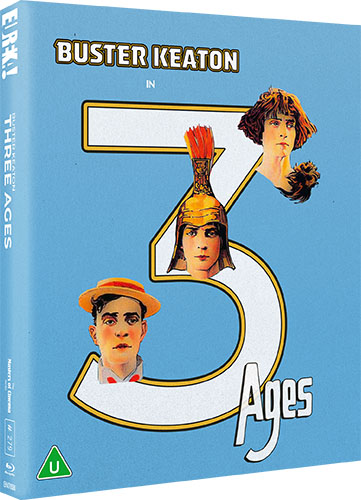
In the Stone Age, Ancient Rome and the Modern Age [well, the 1920’s], the slight but incurably romantic Boy is desperate to win the heart of the Girl, but keeps coming up against the Villain, a macho bruiser….
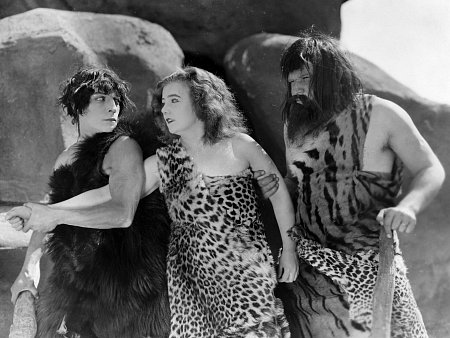
Eureka seem to have released most of Buster Keaton’s silent material, and having only fairly recently become a fan I’d now like to see some of his sound offerings; general opinion seems to be that he was largely wasted when the talkies came but surely there must be some good stuff in there? However, Three Ages also came with great interest. It was his second feature not his first, but it was the first one that he wrote, starred in, directed [well, with Edward H. Kline], and produced. It was clearly influenced by W. S. Griffith’s still-astounding epic Intolerance, which intercut four theme-related stories taking place in different locales and periods. However, specifically constructing it as a three-part feature, also meant that it could also be broken down into three segments running by themselves, to be played as three short one-reelers like previous Keaton efforts. Keaton was seemingly unsure of its commercial prospects, though in the end it turned out to be a success, even if few will probably consider it to be one of his best. That’s not to say that it’s at all best bad though! You’ll still probably get more laughs from it than three modern comedy films. There’s a considerable amount of charm and, while the employment of the “three settings sharing the same story” lets us know that what we’re watching is going to be repetitious, the differences increase as the film goes along. As for the humour, the film offers a lot of hilarious and inventive gags along with some rather laboured ones which sometimes go on for too long. However, Keaton, trying to give his audience more than just the non-stop tomfoolery of his shorts, was still clearly finding his feet so it should be easy to forgive the bits that don’t really work – not to mention a gag that suggests black people are addicted to gambling which can only come across as racist!
Keaton is only fifth-billed, which is rather strange. Mind you, the way the five main characters are introduced not just with their “roles” but are also given the names of the performers playing then is also quite unusual. We first see an old man with a scythe sitting by a table with a skull and other artefacts, Father Tim I suppose, replacing Griffith’s rocking chair, though perhaps surprisingly we never see him again. Still, we do also get the film’s title on the front of a book which opens to reveal text telling us that the only thing which has changed over time is love. First we’re introduced to the Stone Age and the Girl, Margaret Leahy, with the words “Beauty is a part of yesterday, today and tomorrow”. I can’t argue with that. However,“in every age Beauty is sought by the Adventurer”, and one is tempted to wonder for a while if the Villain [or should we just call him Mr. Wallace Beery?], in all three of his incarnations but especially in the Stone Age, has more right to be with her than this rival for her affections who, especially in the Stone Age, seems to spend much of his time lazing around dreaming of the object of his affections than making a success of himself. Did writers Clyde Bruckman, Joseph A. Mitchell and Jean C. Havez intend viewers to think this or is this just the mind of somebody watching the film exactly one hundred years after it was released in cinemas working overtime and thinking of things which were unintended? Whatever, Keaton’s introduction in this movie is something rather special. He’s shown sitting on a rock which then moves with hin on it, but, instead of it being revealed to us that he’s on some anachronistic wheeled device a la The Flintstones, the next cut shows him to actually be sitting on the back of an honest-to-goodness Brontosaurus. So this is the film that first pretended that primitive mankind lives alongside dinosaurs?! The creature is realised by okay stop motion which was actually courtesy of cartoon surpremo Max Fleischer. In a second shot, after we see Beery getting off an elephant, Keaton is now sitting on the dinosaur’s head which he’s allowed to dismount from when the animal lowers his neck!
Well, things can’t get as good as that for a while and seem to be just luke-warm for a bit as we’re introduced to the final two main characters with “youth is eternally protected by the sheltering wing of devoted parents”. Dad has a good way for determining a suitor’s suitability; hit him with a club repeatedly. Unsurprisingly, Keaton fails that test almost immediately. The basic setup is then reintroduced in the other two settings, with Keaton in both situations a person yearning for a woman who’s far more wealthy than him. In the Roman Age he looks at his wristwatch which fails to move, then goes to park his chariot but sees a sign that says, in Latin, “No Parking”. In the Modern Age he’s driving his car alongside the one owned by his father-in-law but it falls to bits when hitting a bump. He fails to impress the parents, their best moment together perhaps being when the father says “I want you to know I’m master of my own house, the choice of my daughter’s husband rest entirely with”, obviously intending to say “me” but quickly adding “, my wife” instead when she suddenly appears, a good example of how humour relying on words can work in a silent film sometimes. Everything Keaton tries to do to win Leahy seems to end in failure. Even trying to make her jealous ends in disaster; when the other woman faints in his presence, he can’t kiss her without making a pig’s ear of it. Eventually the two suitors actually engage in physical activity with each other, but it seems that the decks are stacked against Keaton even if he wins. It’s a slight peculiarity that what seems to be the climax of each story is in every case followed by more material, meaning that there’s a distinct loss of energy in the final fifteen or so minutes, and some viewers today may not like the sight of our heroine being dragged off by her hair with a smile on her face, but then again it’s just mocking the cliche of how cavemen are supposed to have treated their women.
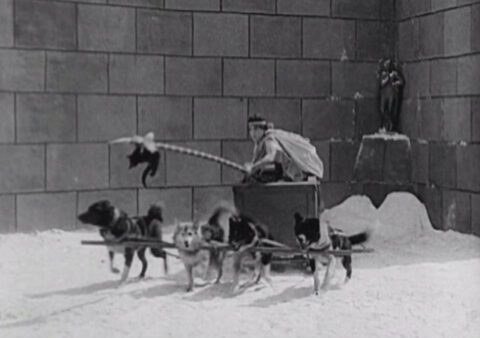
The intercutting of the stories isn’t done with much rhythm or finesse and there’s no speeding up as in the case of Intolerance, though at least this time each tale is has the same amount of time devoted to it. The Roman Age, which also contains an impressive enlarging of the Los Angeles Memorial Colosseum along with lots of moving dolls, contains by far the most laughs, reaching an amazing peak with a chariot race where Keaton’s vehicle is driven by dogs. The sequence, built up to by a joke we don’t get but which is also an interesting visual moment when real horses become drawn horses with the words “spark plug” written on them, is as funny as you want it to be and attains truly hysterical heights when a cat is introduced. The comparable scenes taking place in the Stone Age and the Modern Age [of Speed, Need and Greed] just can’t compare, though they’re still quite funny; Keaton diving between the legs of multiple American football players is memorable. The following Roman Age scene, when Keaton is thrown into a dungeon with a lion, is also priceless in terms of how it ends. Somehow how the poor man-in-suit lion [though there have been worse examples, even decades later, and in supposedly serious films] adds to the comedy. Of course some of the gags involve anachronisms as they do also in the Stone Age; the Modern Age can’t have these to rely on and, despite most of Keaton’s previous work having been set in the present day, does fall flat in a few places, not particularly confident in telling its story and with a few comedic moments involving the three main characters which aren’t as funny as they should be. There’ also an extremely contrived plot point which gives Keaton the chance to swing things in his favour just when it seems that things can’t get any worse for him, but then this is a silent movie after all, and a comedy at that.
I haven’t yet mentioned stunts, and this movie contains a spectacular one, albeit one that’s obviously been pieced together as opposed to being the usual single shot of something amazing, though there’s a reason for this. Supposedly [and I say “supposedly” because it seems that some consider this to be a case of printing the legend rather than printing the facts], Keaton intended to just leap from a board projecting from one building onto the roof of another building, which is awesome enough when you see the distance on screen. However, he fell short, smashing into the brick wall and falling into a net off-screen, something which was also filmed because the camera operators were instructed to always keep filming, no matter what happened. He was injured badly enough to be laid up for three days, but when he saw the footage, he not only kept the mishap, he built on it, adding the fall through three awnings, the loose downspout that propels him into the firehouse and the slide down the fire pole. It’s hugely exciting but, perhaps because there’s no obvious editing together of footage, I prefer a bit during the Roman Age where he does an amazing variety of things with a pole. Keaton and Beery had worked many times in shorts and have their timing togetHer down to a tea. However, Leahy is a disappointment and has neither a strong screen presence nor chemistry with her co-stars. The love story element in Three Ages is almost de-emphasised; we don’t get any sense of the object of Keaton’s affections gradually falling in love with him, but maybe this was a partly because of Leahy’s inadequacy. Were some of their scenes cut because of this?
Not successful in everything but containing a decent variety of humour, Three Ages is nonetheless a fascinating watch, most definitely has its highlights, and ends in a surprisingly modern fashion. But then Keaton himself always seems to be modern in a way, no matter how much time has gone by.
Rating: 









Limited Edition Slipcase [2000 Copies]
1080p presentation on Blu-ray from a new restoration by the Cohen Film Collection
Introductory text informs us that this is sourced from a second generation dupe but that three missing shots, including the very last one, had to be taken from an inferior negative. While never looking as sharp and detailed as some of Eureka’s other Keatons, this one still looks pretty good until some sections towards the end, where considerable print damage has resulted in a flickery, hazy mess where it’s sometimes hard to discern what’s happening. But better that than not at all. The Rodney Sauer score provides perfect musical accompaniment with its catchy themes that recur through all the segments.
Reconstructed original intertitles
Brand new audio commentary by film historian and writer David Kalat
Kalat, who’d already done a commentary for this very film on Kino Video’s 201o0 release [which was replaced by another track on Kino Lorber’s 2019 version] gives is a typically enthusiastic, informative and very easy to follow commentary track. Keaton’s career is nicely summarised without degenerating into film lists and includes some sad stuff about his marriage. We also learn about Gertie The Dinosaur, an early cartoon which in theatrical releases had its director interact with Gertie, which inspired Keaton’s dinosaur gags, Leahy, who was thrown off her first film because of her poor acting and never made another one after Three Ages, and have debunked the idea that Keaton was nervous about this production, even though others on this disc say that he was. The tale of Clyde Bruckling, who was sued three times for borrowing gags from Harold Lloyd, is also memorable. Consistently interesting and brave enough to defend MGM whom many consider wasted Keaton, Kalat is on top from here.
This Side of Impossible – brand new video essay by David Cairns [20 mins]
Eureka have included most of the special features that are to be found on the two Kino versions, though certain ones like the three sections playing seperately to each other and introductions by Orson Welles and Gloria Swanson [curiously only included on the 2010 release] aren’t here. Four new featurettes more than take their place though. Here, the always welcome Cairns tells us that Beery never did his own stunts [despite working with Keaton for so long], explains the “spark plug” reference, and goes through the list of names on the list of football players which is all crew,telling us who they were except for the ones he can’t identify. Cairns, who’s occasionally helped by voiceover, seems to made sure that he doesn’t repeat anything Kalat said – or maybe it was vice versa?
Under the Flat Hat – brand new video essay by Fiona Watson [15 mins]
This fascinating featurette is based on the principle that Keaton suffered from ADHD; I’ll be honest and say that I have wondered about this a few times myself. Keaton was clearly a person who saw and processed things in a different way to most other people. Watson adds much more to back up her claim, from he being almost out of control as a child, to crowds making him throw up, to being an insomniac.
The Six Ages of Comedy – brand new featurette based on an essay by Keaton [1924] [4 mins]
Footage of silent comedy, mostly his own movies, accompanies the reading of brief descriptions of six “ages” of silent comedy, beginning with The Explosion Age and finishing with the Present. Some mild chuckles ensure from lines like, finishing off trhe Bathing Girl Age, “Daddy, can I go for a swim?” “Yes dear but don’t get into motion pictures”.
Brand new interview with Ian Lavender [15 mins]
One can literally feel Lavender’s love for Keaton as he describes seeing The General as a young kid even though it wasn’t supposedly in circulation at that time, to playing Keaton in a play courtesy of his wife, to looking for Keaton’s house and grave; the house has a guard who didn’t even know who Keaton was, while Keaton has Marty Feldman lying next to him. His describing of the essence of Keaton is really rather touching.
Excerpt from “Man’s Genesis” – 1912 short by D.W. Griffith that is parodied in “Three Ages”
Though this is apparently an “excerpt” rather than the whole movie which is probably lost, the basic story seems to be all here. Two cavemen, one of whom lives in a huge skull, fight over a woman, and it’s interesting how much Keaton copied it for Three Ages.
Video essay on the film’s locations by John Bengtson[ 12 mins]
I always enjoy seeing old locations as they are today. The much-used Garden of the Gods rock formation in Chatsworth near Hollywood, which is seen in the Stone Age, is now surrounded by vegetation and buildings, which is rather a shame. We also see the Los Angeles Memorial Colosseum without the extra layer and tiny moving dolls, but just as interesting is that Bengtson isn’t sure about the story of the building jump going wrong and still being used.
1958 Alka Seltzer Commercial [1 mins]
An exhausted Keaton as a postman gets a new lease of life when an tiny animated statue of a girl gives him some Alka Seltzer. There’s also a nice moment where he goes to post a letter and the postbox is revealed to be that of a caravan which then drives off.
“Buster Keaton at Shell Chateau” 1936 radio show appearance [5 mins]
This is pretty funny. Keaton is trying to recite a poem but keeps being interrupted by a man initially selling accident insurance; his retorts include “I don’t know, I haven’t had my last birthday yet” to being asked how old he was on his last birthday.
“Buster Keaton on Art Finley” 1960 radio interview [11 mins]
Finley asks all sorts of questions, including why his style of comedy isn’t done much anyway [“no school for that” he sadly answers]’ professes liking for Red Skelton, Abbot and Costello and Jerry Lewis, and says “an actor must stay out of politics or religion” – if only! Keaton also uses the opportunity to mention and briefly discuss some vintage comedians who he knew.
Buster Keaton 1960 French Radio Interview Excerpt [1 mins]
Keaton seems a bit disgruntled as he says he has no interest in making more films.
A collectors booklet featuring new writing by Philip Kemp and Imogen Sara Smith
Certainly not prime Keaton but an important film in his career, “Three Ages” is a little patchy but still contains moments and sequences of utter genius. Eureka have truly given it the royal treatment. Recommended!


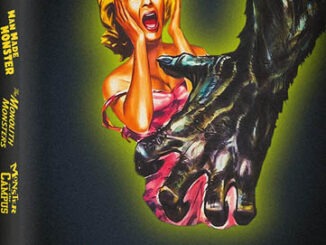

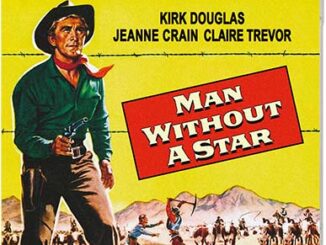
Be the first to comment